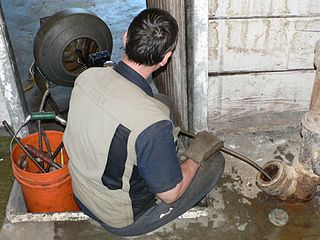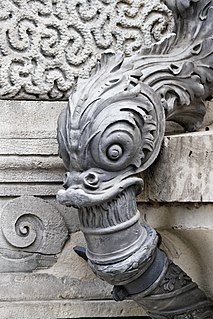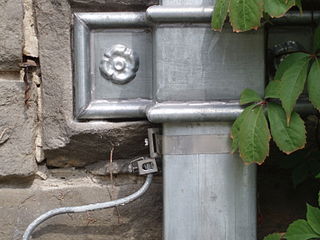
A wiped joint is a form of soldered joint used to join lead pipework.

A wiped joint is a form of soldered joint used to join lead pipework.
The defining characteristic of a wiped joint is that the soldering process involves mechanically working or 'wiping' the joint. [1] As well as heating solder and applying it to the joint, the solder is shaped into place manually, wiping it with a non-metallic tool to form a smooth-surfaced outer shape. This relies on the use of a lead-tin solder with a wide eutectic range. This is an alloy composition that when heated and melted has a large range where it is neither fully solid nor fully liquid, but is an equilibrium mixture of both solid and liquid simultaneously. The resultant 'pasty' texture and mechanical fluidity allows the joint to be wiped to shape.
The solder grade used for leadworking is plumber's solder (80% lead / 20% tin). [lower-roman 1] Although this is thought of as a high melting point solder amongst lead-tin solders, the solidus is relatively constant for all of these solders and it is the liquidus which climbs from the eutectic point at Sn 63% / Pb 37%.
For pipework, the two parts are first formed to shape so as to fit closely. As lead is a ductile metal, this was easily done by hand using a variety of mallets and shaped sticks. Wooden cones could also be used to stretch the diameter of one pipe so that another of nominally the same size could now fit within it. The metal was then cleaned by scraping off the surface, then protecting it with a flux of tallow. [lower-roman 2]
Areas that should not receive any lead were painted with plumbers soil which was a mixture of lampblack and glue; or flour, salt, sugar and water. The lead would not stick to it, and the plumbers soil would be washed off later.
Heat was applied with a blowtorch and when the joint was hot, the end of a bar of solder was applied and melted onto the joint.
The molten solder gives a 'pasty' behaviour, owing to its eutectic properties and can be worked for some time before it hardens. Shaping was done with either a 'moleskin', [lower-roman 3] a heat-resistant pad of cotton cloth, covered with tallow, [2] or else a wooden stick, also greased with tallow.
Wiped joints were used for centuries to install water plumbing and similar joints can be seen in Roman plumbing. [3] As the wiping technique allowed a great deal of on-site flexibility for the style and dimensions of the work produced, this meant that plumbers needed few parts other than pipe, lead sheet and solder. Large and complex joints could all be made by the artisan's skill alone. With the development of copper plumbing, [lower-roman 4] many different types and sizes of factory-made plumbing fitting were needed, which would be assembled on site rather than fabricated from raw materials.
In the later years of lead plumbing, [lower-roman 5] it was recognised that the health effects of lead piping were a problem for drinking water, especially in soft water areas. Tin-lined lead pipes were used, soldered over a thin brass joint liner. These needed care when wiping the joint, in order to not overheat them and melt the tin layer. [4]
Copper to lead joints may be made by wiping the lead onto the copper pipe, as for a lead-lead joint. However the Pb80Sn20 solder used for wiping is poorly wetting onto copper, and so that must be tinned first, using a more tin-rich solder and an active flux.
Lead-sheathed cables were also used for telephone cables, as the lead outer sheath lasted well buried in wet ground. Jointing such cables could also require wiped lead joints. A typical such joint would involve a joint or tee junction between cables, with the copper pairs inside joined by fine soldering and insulating, then the overall joint wrapped in lead sheet and soldered. Such jointing continued until the 1960s and the availability of polyethylene sheathed cables.
Wiped joints continue to be made for as long as there are lead pipes in service. Although lead pipework is now rare, for health reasons, wiping a joint remains the usual way of joining it. Commonly though a joint is to be made by shortening the old lead and installing new copper or plastic piping beyond the joint. These joints are usually made today with a proprietary mechanical joint, sealing onto the soft lead by some mechanical compression ring.
An older technique for body filler on car bodywork, before the plastic age, was the use of body solder. This was a lead-based wiping technique to fill gaps and low spots in steel bodywork, by applying solder with a similar wiping technique and a wooden paddle. The solder used was of even lower tin content, around 10%.

Solder is a fusible metal alloy used to create a permanent bond between metal workpieces. Solder is melted in order to adhere to and connect the pieces after cooling, which requires that an alloy suitable for use as solder have a lower melting point than the pieces being joined. The solder should also be resistant to oxidative and corrosive effects that would degrade the joint over time. Solder used in making electrical connections also needs to have favorable electrical characteristics.

Plumbing is any system that conveys fluids for a wide range of applications. Plumbing uses pipes, valves, plumbing fixtures, tanks, and other apparatuses to convey fluids. Heating and cooling (HVAC), waste removal, and potable water delivery are among the most common uses for plumbing, but it is not limited to these applications. The word derives from the Latin for lead, plumbum, as the first effective pipes used in the Roman era were lead pipes.
A solder ring fitting, also known by the trademarked name Yorkshire fitting, is a pre-soldered capillary connector for joining copper pipes used in plumbing.

Brazing is a metal-joining process in which two or more metal items are joined together by melting and flowing a filler metal into the joint, with the filler metal having a lower melting point than the adjoining metal.

In metallurgy, a flux is a chemical cleaning agent, flowing agent, or purifying agent. Fluxes may have more than one function at a time. They are used in both extractive metallurgy and metal joining.

Wave soldering is a bulk soldering process used in the manufacture of printed circuit boards. The circuit board is passed over a pan of molten solder in which a pump produces an upwelling of solder that looks like a standing wave. As the circuit board makes contact with this wave, the components become soldered to the board. Wave soldering is used for both through-hole printed circuit assemblies, and surface mount. In the latter case, the components are glued onto the surface of a printed circuit board (PCB) by placement equipment, before being run through the molten solder wave. Wave soldering is mainly used in soldering of through hole components.

Gold plating is a method of depositing a thin layer of gold onto the surface of another metal, most often copper or silver, by chemical or electrochemical plating. This article covers plating methods used in the modern electronics industry; for more traditional methods, often used for much larger objects, see gilding.

Reflow soldering is a process in which a solder paste is used to temporarily attach one or thousands of tiny electrical components to their contact pads, after which the entire assembly is subjected to controlled heat. The solder paste reflows in a molten state, creating permanent solder joints. Heating may be accomplished by passing the assembly through a reflow oven, under an infrared lamp, or (unconventionally) by soldering individual joints with a desoldering hot air pencil.
A fusible alloy is a metal alloy capable of being easily fused, i.e. easily meltable, at relatively low temperatures. Fusible alloys are commonly, but not necessarily, eutectic alloys.
Cross-linked polyethylene, commonly abbreviated PEX, XPE or XLPE, is a form of polyethylene with cross-links. It is used predominantly in building services pipework systems, hydronic radiant heating and cooling systems, domestic water piping, and insulation for high tension electrical cables. It is also used for natural gas and offshore oil applications, chemical transportation, and transportation of sewage and slurries. PEX is an alternative to polyvinyl chloride (PVC), chlorinated polyvinyl chloride (CPVC) or copper tubing for use as residential water pipes.

A plumber's snake or drain snake is a slender, flexible auger used to dislodge clogs in plumbing. The plumber's snake is often reserved for difficult clogs that cannot be loosened with a plunger. It is also sometimes called a toilet jack. A plumbers snake is often used by plumbers to clear a clogged drain pipe or sanitary sewer.
A filler metal is a metal added in the making of a joint through welding, brazing, or soldering.

A pipe is a tubular section or hollow cylinder, usually but not necessarily of circular cross-section, used mainly to convey substances which can flow — liquids and gases (fluids), slurries, powders and masses of small solids. It can also be used for structural applications; hollow pipe is far stiffer per unit weight than solid members.

The Lead and Copper Rule (LCR) is a United States federal regulation that limits the concentration of lead and copper allowed in public drinking water at the consumer's tap, as well as limiting the permissible amount of pipe corrosion occurring due to the water itself. The U.S. Environmental Protection Agency (EPA) first issued the rule in 1991 pursuant to the Safe Drinking Water Act. The EPA promulgated the regulations following studies that concluded that copper and lead have an adverse effect on individuals. The LCR sought to therefore limit the levels of these metals in water through improving water treatment centers, determining copper and lead levels for customers who use lead plumbing parts, and eliminating the water source as a source of lead and copper. If the lead and copper levels exceed the "action levels" water suppliers are required to educate their consumers on how to reduce exposure to lead. A 2004-2005 study of the LCR by the EPA noted that the system had been effective in 96 percent of systems serving at least 3,300 people.

A fitting or adapter is used in pipe systems to connect straight sections of pipe or tube, adapt to different sizes or shapes, and for other purposes such as regulating fluid flow. These fittings are used in plumbing to manipulate the conveyance of water, gas, or liquid waste in domestic or commercial environments, within a system of pipes or tubes.
Body solder is a type of solder used to smooth the surface of automobile bodies before painting. It has been largely supplanted by polyester body fillers, such as Bondo, and others, but many purists and auto customizers continue to use body solder, asserting that it bonds better to sheet metal, feels better, wears better, resists higher temperatures, and can be powder coated or otherwise chemically plated.

Soldering is a process in which two or more items are joined together by melting and putting a filler metal (solder) into the joint, the filler metal having a lower melting point than the adjoining metal. Unlike welding, soldering does not involve melting the work pieces. In brazing, the work piece metal also does not melt, but the filler metal is one that melts at a higher temperature than in soldering. In the past, nearly all solders contained lead, but environmental and health concerns have increasingly dictated use of lead-free alloys for electronics and plumbing purposes.

Copper tubing is most often used for heating systems and as a refrigerant line in HVAC systems. Copper tubing is slowly being replaced by PEX tubing in hot and cold water applications. There are two basic types of copper tubing, soft copper and rigid copper. Copper tubing is joined using flare connection, compression connection, pressed connection, or solder. Copper offers a high level of corrosion resistance but is becoming very costly.

Granulation is a jewellery manufacturing technique whereby a surface is covered in spherules or granules of precious metal. The technique is thought to have its origins in Sumer about 5,000 years ago. This technique then spread to southern Europe during the orientalizing period, also through the role of Phoenicians, who had founded colonies in Sardinia, Sicily and Spain, or Near Eastern craftsmen.

Lead burning is a welding process used to join lead sheet. It is a manual process carried out by gas welding, usually oxy-acetylene.
| Wikimedia Commons has media related to Lead pipe plumbing . |